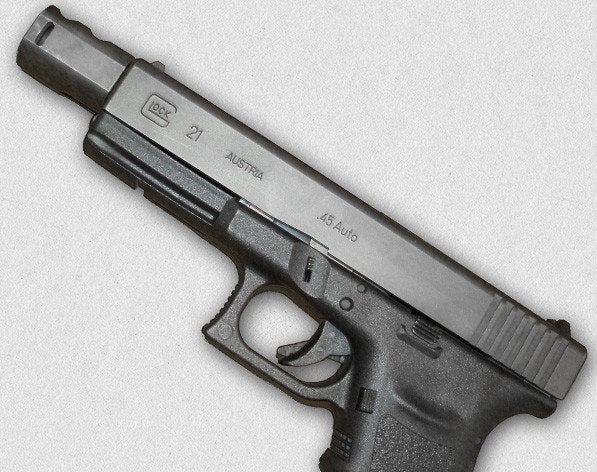The .460 Rowland cartridge packs .44 Magnum power in a cartridge the size of a .45 ACP (the case is slightly longer but the bullet is seated deeper). A number of .45 ACP pistols can be converted to fire the Rowland by simply swapping out the recoil spring and barrel. This is an impressive feat, considering .44 Magnum-level semi-automatics were traditionally gas-powered, such as the Desert Eagle, rather than short recoil tilt barrel action.
The .460 cartridge operates at 40,000 psi, twice the pressure of a .45 ACP, but not much more than the 10mm Auto maximum SAAMI spec pressure despite being a good 25% more powerful. A large compensator is required, both to add weight to the barrel and reduce the recoil.
Jim writes about his experiences with his Glock 21 converted to fire the .460 …
OK, first thing: it didn’t just take the 3 weeks for delivery which was promised. It wasn’t even 3 months. It was almost six months. And a buddy of mine who ordered his before I ordered mine still hasn’t gotten his. So, there’s that.
…
As advertised by .460 Rowland, the conversion takes like 30 seconds. If you can field strip your Glock, you can do the conversion. I’ve opted for using blue loc-tite rather than red, since it still works well but allows me to remove the compensator easily if I need to.
How does it work? Well, I’ve taken it out to the range several times now, shooting both factory rounds as well as my own reloads. Doing some informal chrono tests, I have gotten exactly the kind of performance promised and expected. The Buffalo Bore 230gr JHP were right at 1300 fps. 200gr RNFP reloads were at 1380 fps, and 185gr XTP (JHP) reloads were at 1410 fps. And those reloads are actually fairly mild — just 12.5gr of Longshot powder — based on what data I’ve seen, I could probably push that to 13.5gr without any risk. (Don’t consider this an endorsement — do your own research, and work up your own loads using published data and standard safety practices.)
Standard .45 ACP magazines are used to feed the rounds (in fact you can shoot .45 ACP +P and .45 Super cartridges in a .460 Rowland gun without any problems). The problem Jim faced was that the .460 rounds were wrecking havok on the Glock magazines. In a follow up post Jim writes about a number of tests he ran to determine what exactly was causing magazine problems …
And most important, it is the *power* of the round, not the case length, which seems to cause damage to the unaltered magazines. Shooting the .460 Rowland power loads in the .45 ACP cases demonstrated this. Conversely, shooting the .45 ACP power loads in the .460 Rowland cases didn’t cause any magazine damage at all.
Two additional notes I want to add: the first is that I had pretty consistent problems with the heavy Lead Flat Nose rounds in all configurations. They kept getting jammed up in transitioning from the magazine into the chamber. I’ll probably continue to experiment with this in the future, but I’m not too worried about it, since many guns run into some ammo specific problems.
 Your Privacy Choices
Your Privacy Choices
